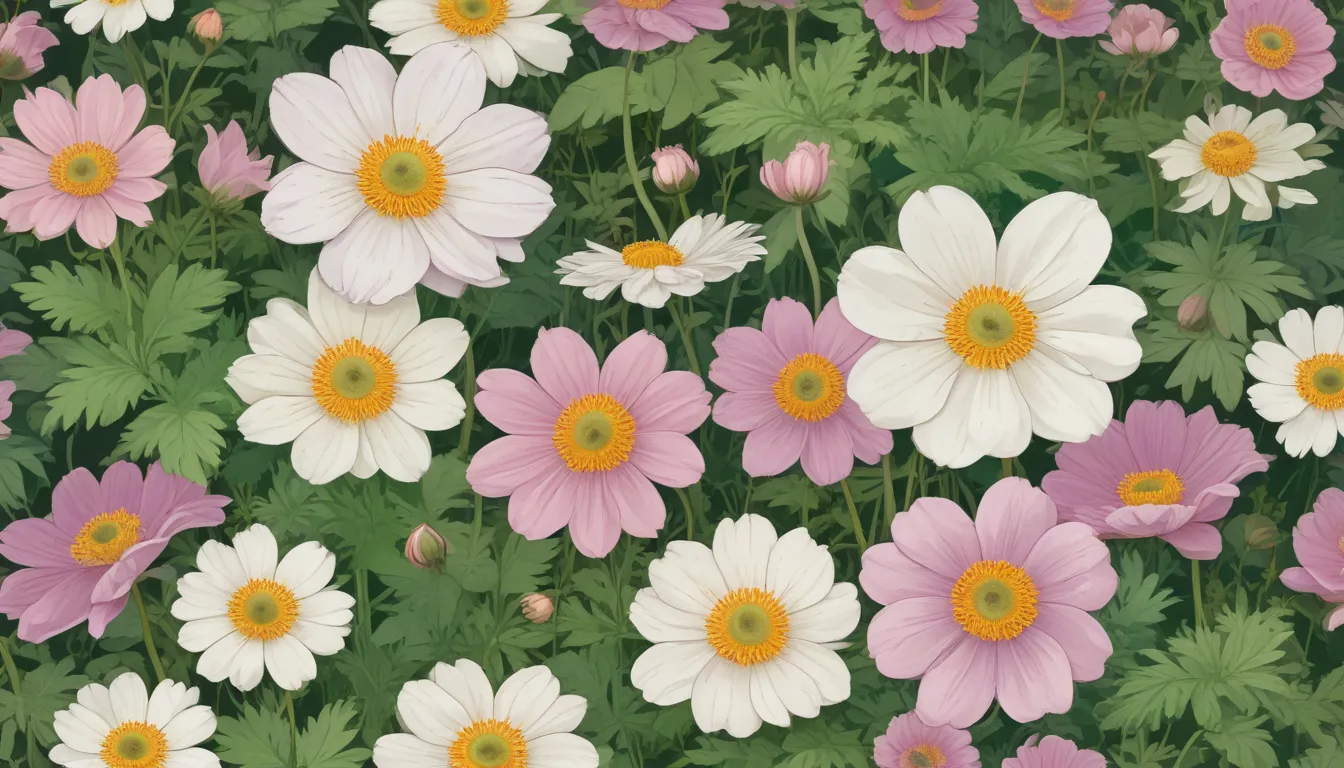How to Plant and Grow Grecian Windflowers (Balkan Anemones): A Comprehensive Guide

If you’re on the hunt for a charming addition to your garden that will brighten up the early months of the year, look no further than Grecian windflowers. These delicate, daisy-like flowers, also known as Balkan anemones or winter windflowers, bloom in a variety of hues, ranging from blue and mauve to pink and white.
Their low-growing, ferny foliage forms a soft ground cover, and their ability to spread readily creates beautiful blankets of color in late winter or early spring. These delightful flowers are versatile and can thrive in a range of garden settings, from borders and rockeries to containers and naturalized areas.
In this in-depth guide, we’ll explore everything you need to know about planting and growing Grecian windflowers, from propagation and cultivation to pruning, maintenance, and managing pests and diseases. Let’s dive in!
What Are Grecian Windflowers?
Anemone blanda, or Grecian windflowers, belong to the Anemone genus, which is part of the Ranunculaceae (buttercup) family. These tuberous herbaceous perennials are native to southeastern Europe, the Middle East, and the Caucasus region, including the Balkans, Turkey, and Greece.
Grecian windflowers are among the first flowers to emerge in the spring garden, often blooming before winter has officially ended. Their name is derived from the Greek word “anemos,” meaning wind, and “blanda,” which translates to mild or charming – a fitting description for these lovely flowers.
These plants typically grow to a height of four to eight inches, forming colorful mats with their charming, daisy-like flowers. While the primary color is deep azure blue, there are many cultivars available in shades of magenta, mauve, pink, white, and even bicolor combinations. The flowers feature golden-green centers and attract butterflies and other pollinators.
With a flowering period of four to six weeks in late winter through early spring, Grecian windflowers go dormant in the summer and fall, with the foliage wilting and dying back about a month after flowering.
A Note of Caution: Grecian windflowers are toxic when ingested and should be kept out of reach of children and pets.
Propagation
Windflowers spread and form clumps through bulb offsets underground, as well as through self-seeding above ground. While new plants can be started from seeds, the results may be inconsistent due to unreliable germination and slow seedling growth. Flowers typically won’t appear until the second year of growth when propagated from seed.
For more reliable results, propagation by root division is recommended. Follow these steps:
- Lift clumps in midsummer after plants have gone dormant.
- Use a garden fork to dig out six to eight inches from the center and lift the fibrous root mass.
- Untangle the roots gently, ensuring each division has a healthy rhizome and crown.
- Replant divisions at the same depth and water thoroughly.
Propagation by division usually results in flowers appearing within three months, making it a more efficient method than seed propagation.
How to Grow
Grecian windflowers are easy to cultivate and are typically planted in the fall. They prefer loose, humus-rich soil that drains well and is kept evenly moist during the growing season. To improve drainage, amend the planting sites with sand or pea gravel to prevent waterlogging, which can lead to root rot. Once the plants have gone dormant, you can allow the soil to dry out.
These plants thrive in full sun but can also tolerate partial shade. When planting the corms, there is no specific orientation required – plant them three to four inches deep in small holes, two to three inches apart.
Before planting, soak the corms overnight to aid in germination. After planting, water lightly and consider adding a winter mulch in regions with prolonged freezing temperatures for added protection.
Growing Tips:
– Ensure good drainage to prevent rhizome rot.
– Mark the plants’ location with a stake to avoid accidental damage when the foliage dies back.
– Provide a winter mulch for protection against freezing temperatures and drying winds.
Pruning and Maintenance
After flowering for four to six weeks, the foliage of windflowers remains for an additional four to eight weeks, storing energy for the next year’s growth. Allow the foliage to yellow and die back naturally, then rake to clean up the area.
For regions outside the recommended hardiness zones of 4-9, dig up the rhizomes and store them for winter. Separate the rhizomes, dry them thoroughly for 10-14 days, and store in a cool, dry location with temperatures between 50-55°F.
Cultivars to Select
Here are some popular cultivars of Grecian windflowers to consider:
A. blanda Mix:
– Showy blend of daisy-like flowers in bicolor blends and shades of blue, pink, and white.
– Perfect for naturalizing under trees or planting in beds, borders, and rockeries.
– Hardy in Zones 4-8.
Blue Shades:
– Flowers in various blue tones with bright white eyes and ferny foliage.
– Ideal for mass planting or mixed with other early bloomers.
– Suitable for full or part sun and hardy in Zones 4-8.
Pink Charmer:
– Delightful daisy-like flowers in magenta pink with chartreuse centers.
– Great for drift planting under trees or mixing with other early bloomers.
– Suitable for full to part sun locations and hardy in Zones 5-9.
For more cultivar options and recommendations, check our guide on 15 of the best anemone varieties.
Managing Pests and Disease
Grecian windflowers are resistant to deer and rodents but may be susceptible to pests and diseases. Some common issues include caterpillars, slugs, snails, leaf spot, powdery mildew, and rhizome rot.
To manage these problems:
– Handpick and dispose of pests like caterpillars, slugs, and snails.
– Remove and dispose of infected leaves affected by leaf spot.
– Control powdery mildew through improved air circulation and removal of infected material.
– Ensure good drainage to prevent rhizome rot and amend the soil as needed.
Best Uses
Grecian windflowers create stunning blankets of color when planted in large drifts or naturalized settings. They thrive under deciduous trees, among short grasses, and in meadows and open woodlands. Mass planting in mixed borders, containers, or perennial beds can also make a vibrant statement.
Consider mixing cultivars for varied displays, or plant them under spring flowering trees for an early burst of color. These versatile flowers can add charm to various garden settings, from rockeries to shady pockets and everywhere in between.
Quick Reference Growing Guide
- Plant Type: Flowering perennial
- Flower / Foliage Color: Blue, pink, white / green
- Native to: Southeastern Europe and Eurasia to the Caucasus
- Maintenance: Low
- Hardiness (USDA Zone): 4-9
- Tolerance: Deer, rabbits and other rodents, salt
- Bloom Time / Season: Early spring
- Soil Type: Loose, humus-rich, evenly moist
- Exposure: Full to part sun
- Soil pH: 6.0-7.5
- Spacing: 2-3 inches
- Soil Drainage: Well-draining
- Planting Depth: 3-4 inches
- Companion Planting: Crocus, grape hyacinth, early daffodils, snowdrops
- Height: 4-8 inches
- Uses: Beds, borders, containers, drifts, lawns, woodland settings, rockeries
- Spread: 3-6 inches
- Family: Ranunculaceae
- Genus: Anemone
- Time to Maturity: 3 months
- Water Needs: Moderate
- Species: blanda
- Common Pests: Slugs, snails
- Common Diseases: Leaf spot, root rot, powdery mildew
Bright Blankets of Color
Grecian windflowers are a delightful addition to any garden, offering a burst of color in the early spring months. With their low maintenance requirements and vibrant blooms, they are sure to bring joy to any gardener.
Remember to provide well-draining soil, keep the plants moist during the growing season, and enjoy the colorful display they offer. Share your favorite garden spots for Grecian windflowers in the comments below and explore more about these beautiful flowers in our related guides.
So go ahead and plant some Grecian windflowers in your garden this year. You’ll be rewarded with a charming display of color and beauty that signals the arrival of spring!





